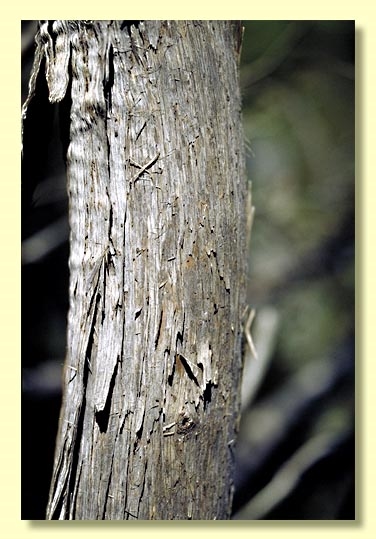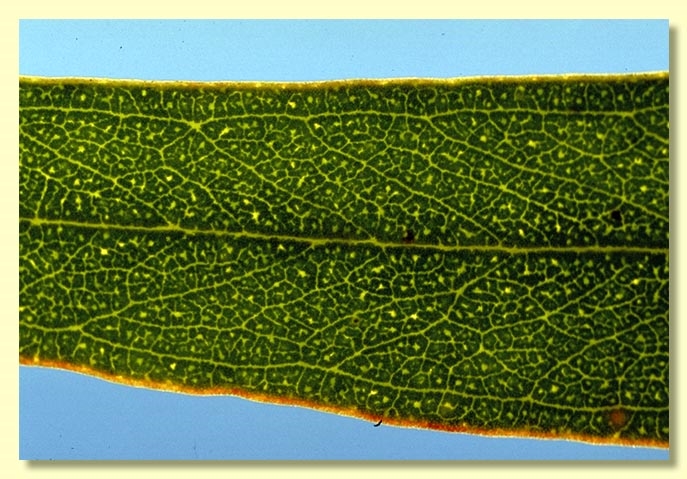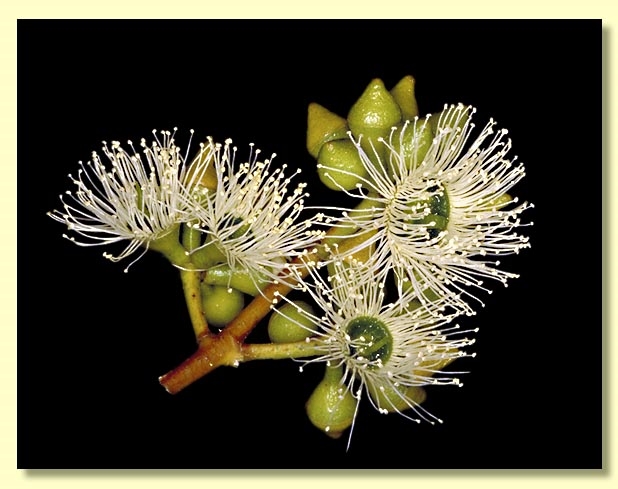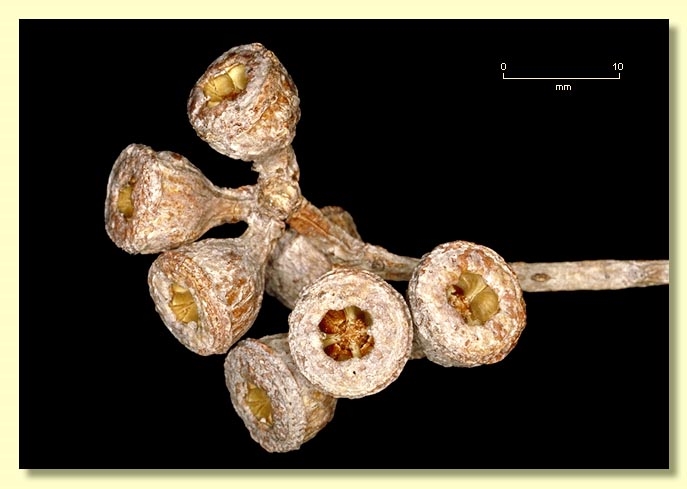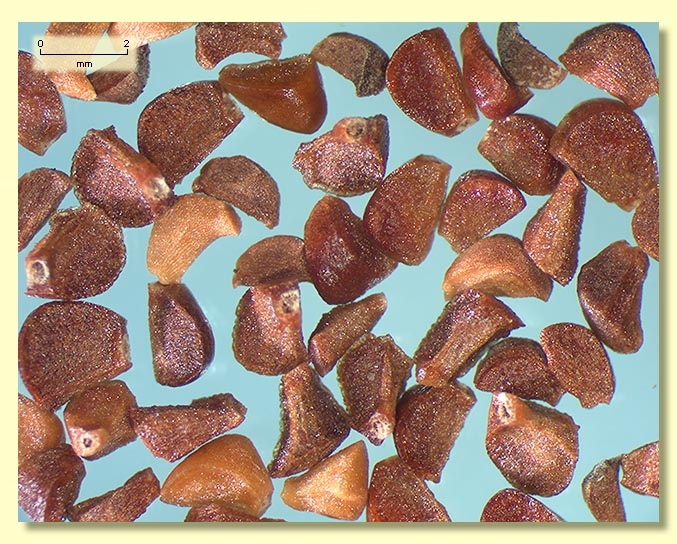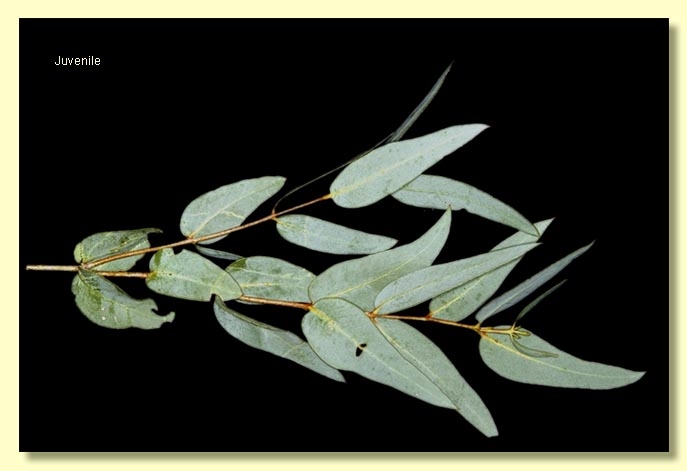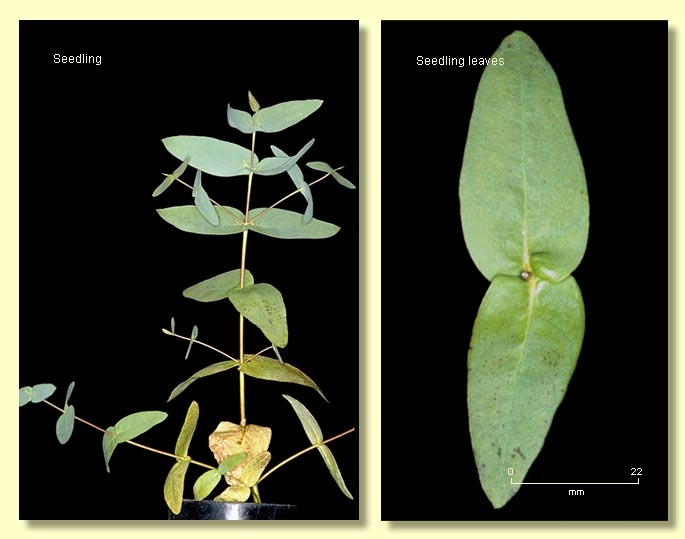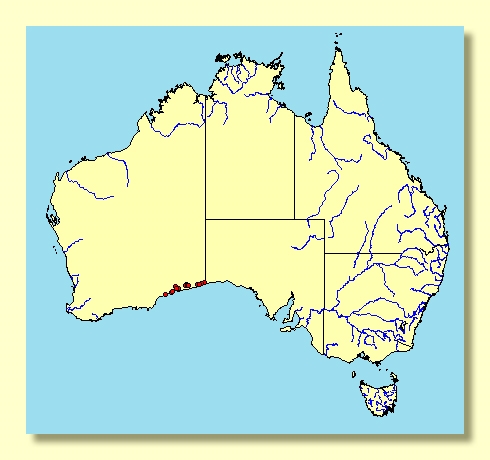Euclid - Online edition
Eucalyptus diversifolia subsp. hesperia
Classification
Eucalyptus | Eucalyptus | Longistylus | Frutices | Diversiformae | Neuropterae
Nomenclature
Eucalyptus diversifolia subsp. hesperia I.J.Wright & Ladiges, Aust. Sys. Bot. 10: 677 (1997).
T: Madura, Western Australia. Limestone scarp opposite turn-off from Eyre Highway (31°53'55"S, 127°01'19"E), Jan. 1995, [I.J.Wright] IW 29; holo: MEL; iso: PERTH.
T: Madura, Western Australia. Limestone scarp opposite turn-off from Eyre Highway (31°53'55"S, 127°01'19"E), Jan. 1995, [I.J.Wright] IW 29; holo: MEL; iso: PERTH.
Description
Mallee to 4 m tall, or shrub. Forming a lignotuber.
Bark rough on lower trunk of shrubs, in mallees extending to ca 4 cm diameter branches, fibrous, greyish brown.
Juvenile growth (coppice or field seedlings to 50 cm): stem rounded in cross-section; juvenile leaves, sessile, amplexicaul to rounded, lanceolate, 4–10 cm long, 1.2–3.2 cm wide, becoming alternate, petiolate, lanceolate, greyish green to glaucous.
Adult leaves alternate, petiole 0.8–1.6 cm long; blade lanceolate to falcate (sometimes), 6.5–11.5 cm long, 0.9–1.8 cm wide, base usually tapering to petiole, concolorous, usually glossy, dark green, side-veins acute, moderately to densely reticulate, intramarginal vein remote from margin, oil glands obscure.
Inflorescence axillary unbranched, peduncles 0.5–1.5 cm long, buds 7, 9 or 11 per umbel, pedicels 0.2–0.7 cm long. Mature buds diamond-shaped, 0.6–1.1 cm long, 0.4–0.7 cm wide, green to yellow, smooth, scurfy or slightly warty, scar absent, operculum conical to beaked, stamens irregularly flexed, anthers oblong, versatile, dorsifixed, dehiscing by longitudinal slits that usually are separate apically, style long, stigma tapered, locules 3 or 4(5), the placentae each with 2 vertical ovule rows. Flowers white.
Fruit sessile or pedicellate (pedicels to 0.3 cm long), more or less cup-shaped to obconical, 0.5–1.1 cm long, 0.6–1.1 cm wide, disc level or raised slightly, valves 3 or 4(5), near rim level.
Seeds brown to reddish brown, 1.5–3 mm long, pyramidal to D-shaped, dorsal surface smooth, hilum terminal (seeds and chaff particles very similar in shape and size).
Cultivated seedlings (measured at ca node 10): cotyledons reniform; stems rounded in cross-section, smooth or slightly warty; leaves opposite, sessile and amplexicaul for at least 10 to 17 nodes, lanceolate to broadly lanceolate, 6–7 cm cm long, 2–3 cm long, at lower nodes the leaves are discolorous and slightly glossy green but become dull grey-green up the stem and more or less concolorous by nodes 8 or 9.
Bark rough on lower trunk of shrubs, in mallees extending to ca 4 cm diameter branches, fibrous, greyish brown.
Juvenile growth (coppice or field seedlings to 50 cm): stem rounded in cross-section; juvenile leaves, sessile, amplexicaul to rounded, lanceolate, 4–10 cm long, 1.2–3.2 cm wide, becoming alternate, petiolate, lanceolate, greyish green to glaucous.
Adult leaves alternate, petiole 0.8–1.6 cm long; blade lanceolate to falcate (sometimes), 6.5–11.5 cm long, 0.9–1.8 cm wide, base usually tapering to petiole, concolorous, usually glossy, dark green, side-veins acute, moderately to densely reticulate, intramarginal vein remote from margin, oil glands obscure.
Inflorescence axillary unbranched, peduncles 0.5–1.5 cm long, buds 7, 9 or 11 per umbel, pedicels 0.2–0.7 cm long. Mature buds diamond-shaped, 0.6–1.1 cm long, 0.4–0.7 cm wide, green to yellow, smooth, scurfy or slightly warty, scar absent, operculum conical to beaked, stamens irregularly flexed, anthers oblong, versatile, dorsifixed, dehiscing by longitudinal slits that usually are separate apically, style long, stigma tapered, locules 3 or 4(5), the placentae each with 2 vertical ovule rows. Flowers white.
Fruit sessile or pedicellate (pedicels to 0.3 cm long), more or less cup-shaped to obconical, 0.5–1.1 cm long, 0.6–1.1 cm wide, disc level or raised slightly, valves 3 or 4(5), near rim level.
Seeds brown to reddish brown, 1.5–3 mm long, pyramidal to D-shaped, dorsal surface smooth, hilum terminal (seeds and chaff particles very similar in shape and size).
Cultivated seedlings (measured at ca node 10): cotyledons reniform; stems rounded in cross-section, smooth or slightly warty; leaves opposite, sessile and amplexicaul for at least 10 to 17 nodes, lanceolate to broadly lanceolate, 6–7 cm cm long, 2–3 cm long, at lower nodes the leaves are discolorous and slightly glossy green but become dull grey-green up the stem and more or less concolorous by nodes 8 or 9.
Flowering Time
Flowering has been recorded in July, August and September.
Notes
Eucalyptus diversifolia is a small to tall mallee species of coastal and subcoastal distribution from south-west of Caiguna in Western Australia east to Cape Nelson in far western Victoria, although absent from the southern Nullarbor area in far western South Australia.
It belongs in Eucalyptus subgenus Eucalyptus series Diversiformae, a group of mallee species characterised by adult leaves held ± erect, buds with a single operculum (hence no operculum scar), ± cuboid anthers that shed pollen by two separate slits, ovules arranged in two rows on the placenta, pyramidal seed and seedling and juvenile leaves opposite for many pairs.
There are two subspecies:
E. diversifolia subsp. diversifolia
Occurs from the Eyre Peninsula east to the lower Yorke Peninsula, Kangaroo Island and the lower south-east of South Australia as far as Beachport and, disjunctly, south of Portland, Victoria. It is a smooth-barked mallee with rhomboid buds and cupular fruit less than 1.2(1.6) cm diameter. Coastal forms may be shrubby while inland, e.g. central Eyre Peninsula, it is distinctive in its erect smooth stems.
E. diversifolia subsp. hesperia
Occurs west of the Nullarbor Plain on the limestone escarpment of the Hampton Tableland from its easterly seaward end near Eucla westwards to Madura, its furthest point inland, and south-west to meet the coast again south of Cocklebiddy continuing towards Point Culver. Plants found on exposed coastal sites are often shrubby to prostrate but always with a hint of rough bark at the base of the stems. Further inland they become tall mallees and have rough fibrous bark over at least the trunks, often extending to smaller branches. Fruits are usually smaller than in subsp. diversifolia but diameters to ca 1 cm do occur.
subsp. megacarpa is not recognised here. It is only weakly separated from the subsp. diversifolia on fruit size alone (diameter > 1.1 cm). Such large-fruited plants are found at Cape Nelson in Victoria and sporadically throughout the range of subsp. diversifolia, including on Kangaroo Island, and are here included in that subspecies.
Eucalyptus diversifolia is closely relared to the Western Australian goldfields endemic species E. platydisca which differs most obviously in having dull blue-green adult foliage and arid rocky mountain habitat.
It belongs in Eucalyptus subgenus Eucalyptus series Diversiformae, a group of mallee species characterised by adult leaves held ± erect, buds with a single operculum (hence no operculum scar), ± cuboid anthers that shed pollen by two separate slits, ovules arranged in two rows on the placenta, pyramidal seed and seedling and juvenile leaves opposite for many pairs.
There are two subspecies:
E. diversifolia subsp. diversifolia
Occurs from the Eyre Peninsula east to the lower Yorke Peninsula, Kangaroo Island and the lower south-east of South Australia as far as Beachport and, disjunctly, south of Portland, Victoria. It is a smooth-barked mallee with rhomboid buds and cupular fruit less than 1.2(1.6) cm diameter. Coastal forms may be shrubby while inland, e.g. central Eyre Peninsula, it is distinctive in its erect smooth stems.
E. diversifolia subsp. hesperia
Occurs west of the Nullarbor Plain on the limestone escarpment of the Hampton Tableland from its easterly seaward end near Eucla westwards to Madura, its furthest point inland, and south-west to meet the coast again south of Cocklebiddy continuing towards Point Culver. Plants found on exposed coastal sites are often shrubby to prostrate but always with a hint of rough bark at the base of the stems. Further inland they become tall mallees and have rough fibrous bark over at least the trunks, often extending to smaller branches. Fruits are usually smaller than in subsp. diversifolia but diameters to ca 1 cm do occur.
subsp. megacarpa is not recognised here. It is only weakly separated from the subsp. diversifolia on fruit size alone (diameter > 1.1 cm). Such large-fruited plants are found at Cape Nelson in Victoria and sporadically throughout the range of subsp. diversifolia, including on Kangaroo Island, and are here included in that subspecies.
Eucalyptus diversifolia is closely relared to the Western Australian goldfields endemic species E. platydisca which differs most obviously in having dull blue-green adult foliage and arid rocky mountain habitat.
Origin of Name
Eucalyptus diversifolia: Latin diversi-, diverse and folium, leaf, referring to the change of leaf form at different growth stages of the plant.
subsp. hesperia: Greek hesperius, west, referring to the western distribution of the subspecies.
subsp. hesperia: Greek hesperius, west, referring to the western distribution of the subspecies.
Copyright © CANBR 2020, all rights reserved.

Web edition hosted at https://apps.lucidcentral.org/euclid


